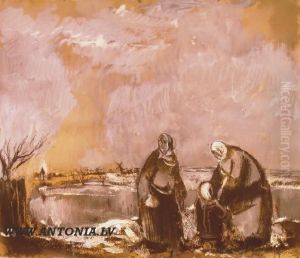Karlis Eglitis Paintings
Karlis Eglitis was a Latvian painter, graphic artist, and art educator, noted for his contributions to Latvian art during the first half of the 20th century. Born on October 15, 1884, in the town of Kuldīga, which at the time was part of the Russian Empire, Eglitis would later become an influential figure in the Latvian art scene, particularly known for his landscape paintings and his involvement in art education.
Eglitis studied at the Kazan Art School in Russia, and furthered his education at the Imperial Academy of Arts in Saint Petersburg. His style was influenced by the national romantic movement, which was prominent in the Baltic states during the late 19th and early 20th centuries. This movement sought to express the cultural uniqueness of the region and often incorporated local folklore, history, and landscapes into its artworks.
After his studies, Eglitis returned to Latvia, where he became an active member of the local art community. He was involved in various exhibitions and art societies, and his works were recognized for their vibrant portrayal of Latvian nature and rural life. Eglitis's paintings often depicted the Latvian countryside, giving viewers a glimpse into the serene and pastoral aspects of the nation's landscape.
In addition to his career as a painter, Eglitis was also a dedicated art educator. He taught at the Latvian Art Academy (today known as the Art Academy of Latvia) and played a significant role in shaping the next generation of Latvian artists. Through his teaching, he emphasized the importance of national identity and the need for artists to draw inspiration from their cultural heritage.
Eglitis's contributions to Latvian art were cut short when he, along with many other Baltic intellectuals and artists, faced severe disruptions during World War II and the subsequent Soviet occupation. Despite these challenges, he continued to work and create art until his death on August 16, 1954, in Riga, Latvian SSR, Soviet Union.
Today, Karlis Eglitis is remembered as a key figure in the development of Latvian national art. His works are preserved and displayed in various museums and galleries throughout Latvia, including the Latvian National Museum of Art, and they continue to inspire both artists and art enthusiasts alike.
